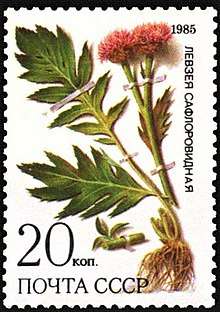Rhaponticum carthamoides
Rhaponticum carthamoides, also known as Maral root or Rhaponticum, is an herbaceous perennial plant from the family Asteraceae[2] that inhabits the sub-alpine zone (4,500–6,000 ft (1,400–1,800 m) above sea level) as well as alpine meadows. It can be found growing wild in Southern Siberia, Kazakhstan, the Altay region, and Western Sayan Mountains. Maral root is widely cultivated throughout Russia and Eastern Europe. This plant derives its traditional name Maral root (Maralu) from the maral deer who fed on it.
| Maral root | |
|---|---|
 | |
| Scientific classification | |
| Kingdom: | Plantae |
| Clade: | Tracheophytes |
| Clade: | Angiosperms |
| Clade: | Eudicots |
| Clade: | Asterids |
| Order: | Asterales |
| Family: | Asteraceae |
| Genus: | Rhaponticum |
| Species: | R. carthamoides |
| Binomial name | |
| Rhaponticum carthamoides | |
| Synonyms[1] | |
| |
Animal studies indicate that maral root may have a beneficial effect on memory and learning in rats,[3] increasing working capacity of tired skeletal muscles,[4] as well as anabolic[5] and adaptogenic processes in rats.[6]
R. carthamoides is high in 20-hydroxyecdysone, one of the most common molting hormones in insects, crabs, and some worms and 20E can disrupt their molting and reproduction.

References
- "Rhaponticum carthamoides". Germplasm Resources Information Network (GRIN). Agricultural Research Service (ARS), United States Department of Agriculture (USDA). Retrieved 2008-02-23.
- SysTax - detailed information on Rhaponticum carthamoides (Willd.) Iljin
- Mosharrof AH (1987). "Effects of extract from Rhapontcum carthamoides (Willd) Iljin (Leuzea) on learning and memory in rats". Acta Physiol Pharmacol Bulg. 13 (3): 37–42. PMID 3439473.
- David Winston & Maimes, Steven. “ADAPTOGENS: Herbs for Strength, Stamina, and Stress Relief,” Healing Arts Press, 2007.
- "Rhaponticum carthamoides: Anabolic effect of whole extract is superior to individual Ecdysterones" (PDF).
- Bespalov VG, Aleksandrov VA, Iaremenko KV, et al. (1992). "[The inhibiting effect of phytoadaptogenic preparations from bioginseng, Eleutherococcus senticosus and Rhaponticum carthamoides on the development of nervous system tumors in rats induced by N-nitrosoethylurea]". Vopr Onkol (in Russian). 38 (9): 1073–80. PMID 1300820.